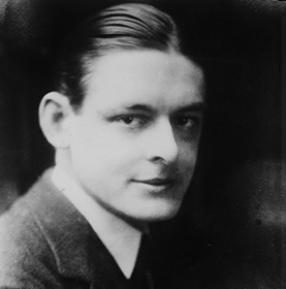
POETRY READING CLUB: SECOND POEM OF THE MONTH ANALYSIS
This week in our Poetry Reading Club we will continue our exploration of mid-twentieth-century poetry with a poem by one of the most important American poets from this era: T.S. Eliot. Eliot exploded onto the literary scene with the publication of his first book of poems, Prufrock and Other Observations (1917). Like William Carlos Williams, Eliot’s early success as a poet owes much to the efforts of Ezra Pound, editor extraordinaire of the early-twentieth-century avant-garde literary world. But except for this friendship with Pound, the two poets have little in common. Unlike Williams, whose literary career was very much tied to his life in small-town America, Eliot left the Midwest and made a name for himself in London, where he lived until his death in 1965.
Last week we coined the term “domestic poetry” to describe Williams’s treatment of his poetic subjects: an idyllic farmyard scene, perhaps glimpsed by someone looking up from his work; a note left on the fridge from a husband to a wife. Williams’s concern with the “things” of the world led him to celebrate the minutia of American life, to pay homage to it in his startlingly short poems. (Although, on occasion his selection of subject matter from the truly ordinary things around us could be quite shocking. Check out his poem about the death of the household cat.) Even in his more erotic and Whitman-esque “Love Song” Williams does not separate the secular from the sacred; in fact, the ordinarily mundane chores of sweeping the kitchen and washing the curtains are an essential part of the ritual of domestic love.
By contrast, Eliot’s is a modern poetry, sophisticated, intellectual, and, above all, urban. The opening lines of the poem place us firmly in a very different landscape than Williams’s “The Red Wheelbarrow”. But for all its emphasis on London’s risqué restaurants, museums, and high-society afternoon teas, Eliot’s IIE s most remarkable perhaps because it is a poem in which nothing actually happens. Williams’s speaker who urges his lover to “put on a clean dress and come with me!” celebrates the love he feels in this life and expresses his assurance that their love will endure after the lovers themselves are gone; he uses the clear, simple vernacular of ordinary people to do so. There is nothing so direct in “The Love Song of J. Alfred Prufrock.” Eliot’s Prufrock never quite manages to ask that “overwhelming question” of his. He is a man of the world, as the references to Dante, Shakespeare, and Michelangelo make clear, but one wonders what good it has done him. Right from the beginning there is a curious world-weariness about Prufrock. As the stanzas about the fog make clear, this is a world in which indirection and indecision are the order of the day.
Where Williams’s poems gesture at the story behind the image, much like a photograph or still life, and leave the exact details to our imagination, “The Love Song of J. Alfred Prufrock” tells us a story. What, in your opinion, is Prufrock’s story? Listen to a wonderful recording of Anthony Hopkins reading the poem here to help you decide. Hopkins’s interpretation brings out the narrative quality of the poem, unlike (in my opinion) Eliot’s reading, which has a rather stiff and off-putting quality.
I have thoroughly enjoyed your observations, questions, frustrations, and delights in each of our sessions. I look forward to seeing you on Tuesday for one more excellent discussion of poetry this year.
Happy reading,
Chiara Luis. Poetry Book Club moderator.
More details about the session at the IIE Agenda.



